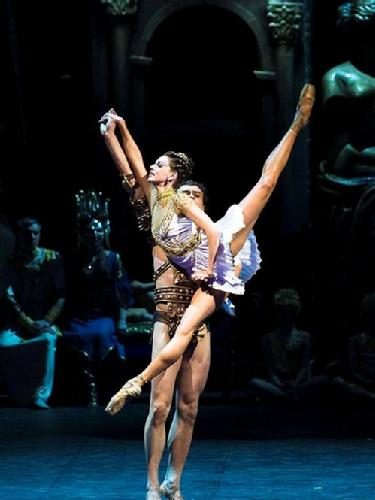Bedtime Stories: Spartacus
Tonights bedtime story is not the kind of story you tell kids when they can’t sleep! With murder, violence, sex and a terribly sad ending, Spartacus is one of those bedtime stories for us over 18.
ifj. Nagy Zoltán and Alejzsa Popova
We are set in old Rome, where the Roman consul Crassus returns to his camp from his latest conquests in a great triumphal procession. He has been out plundering, conquering, doing all what those old romans really knew how to, and brings back a pack of captives to join his stock of slaves in his camp. Among them are the Thracian king Spartacus, and his wife, the beautiful Phrygia. They are – obviously – not very happy to be there, especially does it torn Spartacus that his wife will be sent to become one of Crassus many concubines in his harem. They have a tearful goodbye, and as the women is mercilessly sent to the harem, a soldier pulls Spartacus and another slave out of the mourning group, to fight until death to entertain the roman consul.
The characters in Spartacus are blessedly easy to understand: Spartacus is the noble hero, fighting, dying for his people if he must. Crassus on the other hand, is a cold and calculating tyrant, evil as the devil himself. You have to watch Spartacus as you would watch the average Bruce Willis movie: Seductive women, hard-as-stone men, evil villains, and although packed with action, not necessarily providing the greatest challenges for the actor. But let’s get back to the story!
Spartacus has no choice but to fight his fellow slave, ending with the other guy getting killed (obviously, anything else would be terrible for the storyline). Horrified by his deed, Spartacus incites his fellow captives to a rebellion against the romans. They agree, and together, the captured men brakes out from their caves. As the curtain closes on the first act, we see the slaves celebrating their freedom – but they still have to free their women…
In the second act, we are based in Crassus’ harem. The news of the captured men’s escape is bothering him, but not enough that he doesn’t want some entertainment. Together with a group of Roman patricians he is watching an extravagant show including naked women and booze, ending with a fight between two blindfolded gladiators. But don’t you think that is the end of the entertainment. As one of the gladiators gets sliced into pieces, the seductive Aegina, leader of Crassus’ concubines, incites a sexual orgy with the roman noblemen. After all, they are in a harem. In the middle of the, well, act, Spartacus and his men bursts into the harem, taking the Romans with their pants down, literarily speaking. But they do not engage a fight with Crassus and his crew, they need to rescue the captured slave women, and especially, his beloved Phrygia. As Spartacus men leaves with their women, Aegina insists that Crassus peruse the slave army immediately, without Crassus showing too much affection. He does still have other women to entertain himself with.. Spartacus and Phrygia celebrates their escape by dancing their famous, and endlessly beautiful Adagio.

Spartacus: A ballet of epic measures, testosterone and some really impressive “tricks” ![]()
Without me knowing exactly why Aegina takes such an interest in this slave-business, fact is, she is deeply insulted by Spartacus’ intrusion in her harem. She sets after the slave army in secrecy, and the next morning, she discovers our loving couple emerge from a tent in a camp nearby. She immediately sends word to Crassus, and this time, he takes interest, and sends his army to kill them. As the slaves learn that Crassus’ army is approaching, internecine struggles break out. Some want to flee, others wants to fight Crassus’ army. But internal problems is never good in a warfare, and when Crassus’ trained roman soldiers arrive, they have no problems slaughtering the remains of Spartacus’ small rebellion. After the battle, the slave women appear from their hidings, and recovers the remains of their husbands and brothers on the battlefield in what has to be one of the most gruesome scenes in the ballet-repertory. Only Phrygia can’t find her beloved Spartacus amongst the dead. As the sun rises, they all find him, crucified on the top of a nearby hill. as the curtain sets on the final act, Phrygia is breaking down, mid stage, crying of the loss of her love…
Want to read more Bedtime Stories? Click here
Merciless truths – Facts about Spartacus:
Background: There was an actual Spartacus, and the ballet follows his exploits of the slave uprising agains the Roman empire known as the Third Servile war. That said, ballet-people has always been suckers for great stories, but they are not necessarily famous for being great historians. So what if the great Thracian Spartacus wouldn’t recognize the plot of the ballet in his name? The story rocks!
Music and choreographic history: The music was written by the soviet-russian composer Aram Khachaturian in 1954, for which he was awarded a Lenin Prize the same year. The ballet premiered in the Kirov (today Mariinsky) theatre in Leningrad (today St. Petersburg) in 56, choreographed by a Leonid Yakobson. The performance was not a great success, the main criticism was towards the fact that none of the women went en pointe. The Bolshoi theatre in Moscow also staged the ballet in 58, to a choreography by Igor Moiseev. However, it was first in 1968, to the choreography of long-time Kirov director Yuri Grigorovich that the ballet achieved great success. Maybe because of it’s (fairly) modern background, or maybe because it was choreographed in the communistic soviet, the ballet tends to remain more prominent in eastern theatre’s repertoires today, than in the west.
The Adagio of Spartacus and Phrygia has (not surprisingly, it is really, although a tad over-dramatic, one of the most beautiful tunes I know) been featured a lot in TV, films and on several stages ever since it was written. To mention a few, it was used as the main love theme in the movie Mayerling, it accompanied the winners of the 2009 world figure skating championships and became a popular song named “Journey’s End” when it was recorded with words by Tony Hiller and Nicky Graham in 1984. Still, the coolest feature is when it was used to accompany the little teethed animal falling in love in the animated film Ice Age 2 in 2006, and again in the sequel, Ice Age 3 in 2009.
In January 2010, a tv-series called “Spartacus, blood and sand” premiered on Starz television. I have not seen any of the episodes, but I’d guess it’s, well, blood and sand, basically… ![]()


